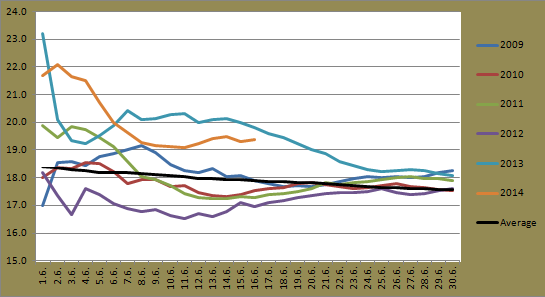While the 20C barrier has been broken in other locations during the past 3 days, Jyväskylä hasn't hit the mark since June 11. It came close over the weekend though with tops of 19.0C and 19.5C on Saturday and Sunday. Today is the 19th consecutive day below 20C. The graph below shows the longest stretches below 20C for each summer since 2009.
 |
| Highest number of consecutive summer days below 20C in Jyväskylä for the summers of 2009-2014 (as of June 30 2014) |
This current streak is more than double the longest runs of both 2009 and 2010. It's also running deep into what is normally the warmest time of the year rather than the typical time of late August. Based on forecasts for the coming days, the run should go until Saturday, a total of 23 days.
Warm temperatures were seen in Sydney late last week but they dropped yesterday. While Jyväskylä struggles to climb above 20C, Thursday to Saturday at the Airport all saw a daily maximum above the mark. It is quite unusual though. Since 2000, only 4 years have seen 3 or more consecutive days above 20C around this time of the year.
The month's warmest temperature of 23.2C was recorded on Saturday. As mentioned in a previous post, winds have been quite strong for the past week in Australia's south-east. A very strong and gusty westerly change dropped temperatures quickly in the late afternoon on Saturday. Yesterday only reached 17.4C and with a maximum of 16.6C, today was the equal second coldest day of the month.
June 25's 85km/h gust didn't hold the title for the strongest of the year for very long. The westerly change on Saturday saw a strongest recorded gust of 94km/h. December 5 last year also recorded a gust of the same strength, as did October 29 and August 12. No other gust recorded last year was higher than 94km/h.
Rain and snow has been affecting parts of Victoria and southern New South Wales for the past week, but Sydney has remained precipitation free since June 16. It should continue like this for the time being as well.

















